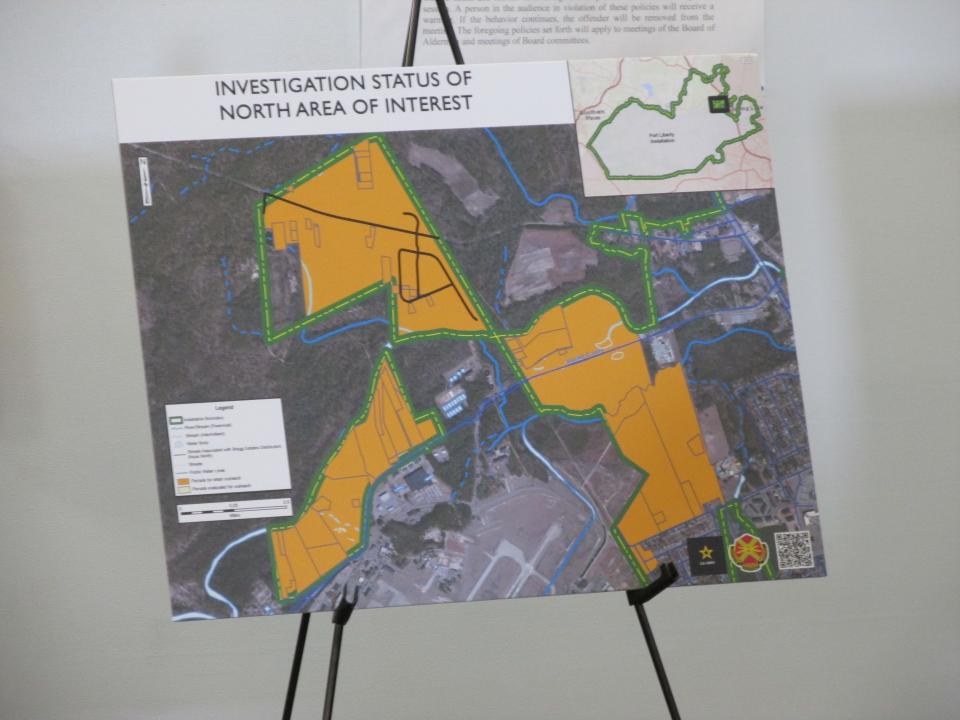‘What’s going on with the water?' Fort Liberty continues chemical testing in Spring Lake
SPRING LAKE — Shirley Hargrove received a letter this month from Army officials telling her there would be a meeting Thursday night concerning the well water at her Spring Lake home.
Hargrove, who worked at Fort Liberty when it was known as Fort Bragg and has lived in Spring Lake for more than 50 years, said “she heard something about water” years ago, but didn’t hear anything else.
The purpose of Thursday night’s meeting was to inform Spring Lake residents of testing being done for the presence of perfluorooctanoic acid and poly-fluoroalkyl substances,
Commonly known as PFOA, PFAS, or "forever chemicals," the substances have been linked to adverse health outcomes and are used in manufacturing household products, industrial processes and firefighting foam.
The firefighting foam has been used on the installation since the 1970s for putting out fires, said Paul Humphrey, chief of the Fort Liberty’s Environmental Division.
Officials are seeking to test the well water of residences within a 1-mile radius of Fort Liberty's Pre-Ranger facility, Pope Army Airfield and Simmons Army Airfield, said Col. Chad Mixon, Fort Liberty's newest garrison commander.
“The Army remains committed to taking care of our people and the communities in which we serve,” Mixon said.

Hargrove said the homes in her neighborhood off Riverside Circle are on well water, and though she stopped drinking it years ago, she still cooks and showers with it.
She said Thursday night’s meeting was a wake-up call.
“It makes you really stop and think, ‘What’s going on with the water?'” she said.
Fayetteville resident Kelly LeGrand also attended Thursday night’s meeting because she owns three properties in Spring Lake that have been passed down for generations. She also received a letter telling her about Thursday's meeting.
“Up until this week, it’s the first time we’ve heard of anything,” LeGrand said.
LeGrand said the properties have been in her family for years and relatives in their 80s and 90s live on them, as does one pregnant family member and children.
The water is used for eating, cooking, showering and mixing baby formula, she said.
LeGrand said that while they wait for the Army’s results on the water, they will be proactive by using bottled water and boiling the well water.
“It’s a process just to prepare because we don’t know and want to be safe,” she said. “It's a full education process for everybody.”

Fort Liberty's use of chemicals
Humphrey said that in 2016, the Environmental Protection Agency established a lifetime health advisory that the Department of Defense adopted which states that the chemical is a concern when 70 parts per trillion or more are detected.
Humphrey said that since 2016, the Army and Department of Defense have worked toward using non-chlorinated firefighting foam and that officials have started to review records to identify where training or emergency response with the chemicals were used.
Based on the assessments, he said, there are 43 “areas of interest” where the chemicals were used, with Pope Army Airfield and Simmons Airfield being the main locations where the groundwater could have been contaminated.
Humphrey said that in 2021 officials started reviewing property records and contacted private owners last summer, resulting in 12 wells being tested.
He said that of the 12 wells tested, six had no detectable PFAS, four were below guidelines and two were below the EPA’s new maximum contaminant level for community water systems of four parts per trillion.
All 12 properties were below 70 parts per trillion, and four were between 4-70 parts per trillion, he said.
While Spring Lake’s well water isn’t a community water system, Humphrey said the Army is being proactive.
Humphrey said that if anyone is above the threshold, Army researchers are assessing “the best approach,” for residents needing an alternative water source, whether it’s connecting them to a community source, using filtration systems or bottled water.

What's next?
Once test results come back, he said, letters will be sent to the private well owners to notify them of the results.
Mixon said Fort Liberty is working with partners like the North Carolina Department of Environmental Quality and Army Environmental Command.
“We’ll remain transparent and continue to get information out,” he said.
Spring Lake residents who think they may have impacted water can visit Fort Liberty’s website.
Staff writer Rachael Riley can be reached at rriley@fayobserver.com or 910-486-3528.
This article originally appeared on The Fayetteville Observer: Fort Liberty seeks more property owners to test water for PFAS

